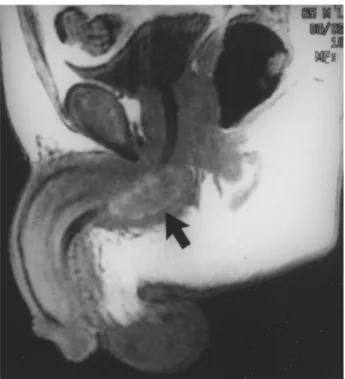431
URETHRAL METASTASIS OF LUNG CARCINOMA Case Report
International Braz J Urol
Official Journal of the Brazilian Society of Urology
Vol. 29 (5): 431-433, September - October, 2003
URETHRAL METASTASIS OF LUNG CARCINOMA WITH GERMINATIVE
CELL FEATURES
MARCOS V. TEFILLI, STEPHEN D. STEFANI, MIRANDOLINO B. MARIANO
Department of Urology and Oncologic Clinic, Mãe de Deus Hospital, Porto Alegre, RS, Brazil
ABSTRACT
Introduction: We present the case of a patient with urethral metastasis of a lung carcinoma with germinative cell features.
Case Report: A White, 57-year old man underwent urologic assessment due to gross hema-turia. Patient was being treated with chemotherapy and radiotherapy during the past 3 months due to primary carcinoma of the lung with brain metastasis. Urethrocistoscopy and nuclear magnetic reso-nance imaging revealed a stenosing mass invading the bulbomembranous urethra. No other tumor was found. Biopsy specimens, obtained from the lung, brain and urethra tumors, revealed the same neoplasia, with definitive diagnosis being undifferentiated giant cell carcinoma of the lung with ger-minative features. Considering his clinical condition and poor prognosis, a decision was made to treat the patient only clinically. Clinical conditions deteriorated and the patient evolved to death within 3 months.
Comments: As far as we were able to access, urethral metastasis from lung carcinoma had never been described in the indexed literature. Due to the extremely limited experience with these tumors, there is not a defined treatment and the prognosis remains quite poor.
Key words: urethra; metastasis; lung cancer; germ cell cancers
Int Braz J Urol. 2003; 29: 431-3
INTRODUCTION
Urethral cancer is rare, corresponding to less than 1% of all malignant neoplasias in humans. Until now, approximately 650 cases of primary carcinoma of urethra were reported in the English-language lit-erature, most often epidermoid carcinomas (1,2). Secondary involvement of the urethra by malignant tumors is uncommon, unless there is direct invasion from primary neoplasias of adjacent organs (2). We report a case of urethral metastasis secondary to a primary carcinoma of the lung with germinative cells features. According to the bibliographic review con-ducted, this is the first case reported in the litera-ture.
CASE REPORT
432
URETHRAL METASTASIS OF LUNG CARCINOMA
without evidence of prostatic or vesical involvement. Nuclear magnetic resonance imaging of the pelvis evidenced a single solid lesion measuring approxi-mately 4.7 x 1.9 cm invading the bulbomembranous urethra (Figure-1). No other tumoral lesion was found in any other location.
Biopsy specimens obtained from lung, brain and urethra contained the same neoplasia, with the histological diagnosis being defined as undifferenti-ated giant cell carcinoma of the lung with germina-tive features. Microscopically, the biopsies presented a combination of atypical polygonal cells and some multinucleated giant cells, suggesting the dysmorphic pattern of choriocarcinoma (Figure-2). Extensive ar-eas of necrosis and hemorrhage occupied a large pro-portion of the tumor and there was no squamous or glandular differentiation. Immunohistochemical analysis revealed positivity for hCG in isolated giant cells and multifocal positivity for alpha-fetoprotein in the polygonal cells. Cytokeratins (AE1 + AE3) were diffusely positive.
With every therapeutic possibility depleted and presenting poor clinical conditions for any
addi-tional therapy, the patient showed a progressive dete-rioration of his clinical condition and died within 3 months. During this period, he persisted with even-tual gross hematuria and developed an acute urinary retention, which was treated with suprapubic cath-eterization.
DISCUSSION
Urethral metastases from lung carcinomas were never reported in the literature. The main sources of metastatic tumors to the urethra are the gastrointes-tinal tract, the bladder and the prostate, almost al-ways invading it by contiguity (1,2). The disease’s presentation pattern in this case, giant cells carcinoma of the lung with germinative features and urethral metastasis, is unique and a hematologic dissemina-tion route would be the most probable explanadissemina-tion.
Primary choriocarcinoma of the lung is the main differential diagnosis to be considered with the undifferentiated giant cell carcinoma of the lung with germinative features (3). Clinically, metastatic tumors from other potential sites such as gonads or mediasti-num to the lung must be excluded (2,3). With only 22 cases of primary choriocarcinoma of the lung re-ported, the diagnosis is established basically accord-ing to the same criteria used for the diagnosis of ges-tational choriocarcinoma (3). The differential histo-pathological diagnosis between primary choriocarci-noma of the lung and undifferentiated giant cell car-Figure 1 – Nuclear magnetic resonance imaging showing
ure-thral metastatic lesion (arrow).
433
URETHRAL METASTASIS OF LUNG CARCINOMA
cinoma of the lung with germinative features is diffi-cult and sometimes arbitrary, since the differences between them are often subjective and dependant on a proper sampling. While the primary choriocarci-noma of the lung contains a large amount of multi-nucleated cells, similar to the sincitiotrophoblast, which will present a strong immunoreactivity for hCG, those are not very frequent in undifferentiated giant cell carcinomas of the lung with germinative features. These histopathological and immunohis-tochemical findings are reflected in the serum values of hCG, which tend to be much higher in cases of primary choriocarcinoma of the lung (above 1000 mIU/mL) (3). The malignant potential of the primary choriocarcinoma of the lung is comparable to that of the undifferentiated giant cell carcinoma of the lung with germinative features and, in both cases, is ex-tremely high.
Considering the limited experience with this type of neoplasia, therapeutic recommendations can-not be made. These tumors have an aggressive be-havior and the prognosis is uniformly serious.
REFERENCES
1. Ray B, Canto AR, Whitmore WR Jr: Experience with primary carcinoma of the male urethra. J Urol. 1977; 117: 591-4.
2. Tefilli MV, Gheiler EL, Shekarriz B, Oliveira JG, Tiguert R, Grignon D, et al.: Primary adenocarcinoma of the urethra with metastasis to the glans penis: suc-cessful treatment with chemotherapy and radiation therapy. Urology. 1998; 52: 517-9.
3. Ikura Y, Inoue T, Tsukuda H, Yamamoto T, Ueda M, Kibayashi Y: Primary choriocarcinoma and human chorionic gonadotrophin-producing giant cell carci-noma of the lung: are they independent entities? His-topathology. 2000; 36: 17-25.
Received: April 4, 2003 Accepted after revision: July 17, 2003
Correspondence address:
Dr. Mirandolino Batista Mariano Rua Costa, 30 / 803
Porto Alegre, RS, 90110-270, Brazil Fax: + 55 51 3231-7247
